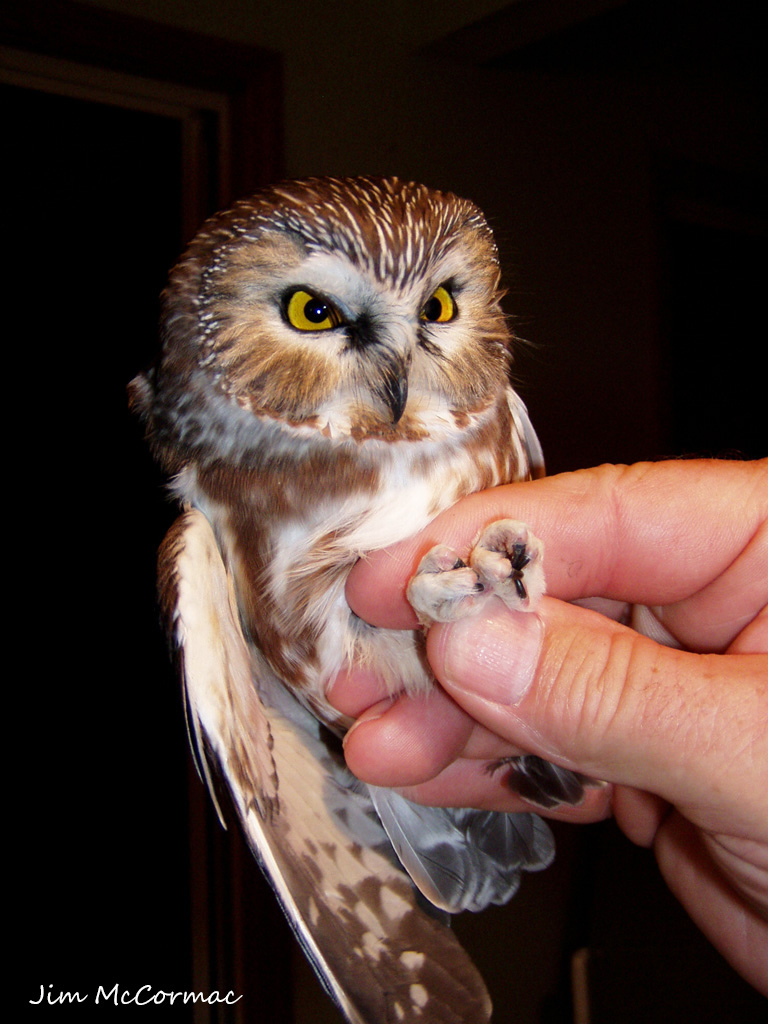That Really Is a Live Owl's Eyeball, Seen Through Its Ear

Some say that eyes are the windows to the soul. But in owls, the ears are literally windows to the animals' eyeballs.
Unnerving glimpses of the inside of an owl's head — in which a view of the bird's sizable bluish-white eyeball is visible through its ear hole — were captured in photos by writer and naturalist James McCormac, author of "Birds of Ohio" (Lone Pine Publishing, 2004), who shared the images with Live Science.
Like all birds, owls lack the external ear structures found in most mammals; the birds' ears are unadorned openings in their skulls, visible only when the feathers on the sides of the animals' heads are parted. But these owls' unusually large earholes and eyes also offer a "behind the scenes" peek at their visual system, showcasing the evolutionary adaptations in sight and hearing that make the birds so successful at stealthy nighttime hunting, McCormac told Live Science. [Whooo Knew? 10 Superb Facts About Owls]
McCormac photographed his owl subjects — northern saw-whet owls (Aegolius acadicus) — in southern Ohio during a data-collection initiative by Project Owlnet. In this effort, scientists and members of the public track this owl species to understand the bird's migration patterns.
Twice a year — in the fall and spring — participants in the project use audio recordings that mimic the owls' calls to lure the animals into nets, and then the researchers attach bands to the owls' legs, according to the Project Owlnet website. Before the birds were released, McCormac had the opportunity to take a closer look at their heads — and to snap photos of the gaping holes showing the bulging sacks of the animals' eyeballs, he told Live Science.
Northern saw-whet owls are small, measuring just 7 to 8 inches (18 to 21 centimeters) tall and weighing about 2 to 5 ounces (65 to 151 grams), according to a species description published online by the Cornell Lab of Ornithology.
And the tiny owls' eyes make up about 5 percent of their body mass, McCormac said. Though most owls have large eyes and earholes, the unusual proportions of the northern saw-whet owls' eyes relative to their bodies make it easier to spot the animals' eyeballs through their earholes, McCormac explained.
Get the world’s most fascinating discoveries delivered straight to your inbox.
"That's quite extreme — even for an owl — to have that much of the eye visible," McCormac said.
Even if owls' ears didn't showcase the insides of their heads, their ears would still be considered impressive adaptations. Most owls — though not all — are nighttime hunters, and their exceptional hearing helps them to locate their fast-moving meals in the dark. Owls' ears are bigger than most birds' and in many species they are positioned asymmetrically on their heads, offset by as much as 0.4 inches (10 millimeters). This allows the birds to triangulate incoming sounds more accurately, because sounds reach each ear at a slightly different time, McCormac said.
Then, the owls' brains process the slight differentiation in the sounds' arrival times, "and that's why they can unerringly pinpoint an object, sight unseen," he said.
Owls have fascinated people for thousands of years, judging by evidence dating to at least 29,000 to 34,000 years ago, when an unknown Paleolithic artist carved the first known image of an owl on the wall of Chauvet Cave in France.McCormac's views of northern saw-whet owls' ears and eyes suggest that there are still plenty of reasons why people continue to find owls compelling — himself included, he told Live Science.
"They're fascinating on so many levels — the nocturnal 'stealth bomber' hunting, the interesting vocalizations, the history, the different emotions they arouse. I could go on and on about them," he said.
Original article on Live Science.

Mindy Weisberger is a science journalist and author of "Rise of the Zombie Bugs: The Surprising Science of Parasitic Mind-Control" (Hopkins Press). She formerly edited for Scholastic and was a channel editor and senior writer for Live Science. She has reported on general science, covering climate change, paleontology, biology and space. Mindy studied film at Columbia University; prior to LS, she produced, wrote and directed media for the American Museum of Natural History in NYC. Her videos about dinosaurs, astrophysics, biodiversity and evolution appear in museums and science centers worldwide, earning awards such as the CINE Golden Eagle and the Communicator Award of Excellence. Her writing has also appeared in Scientific American, The Washington Post, How It Works Magazine and CNN.




